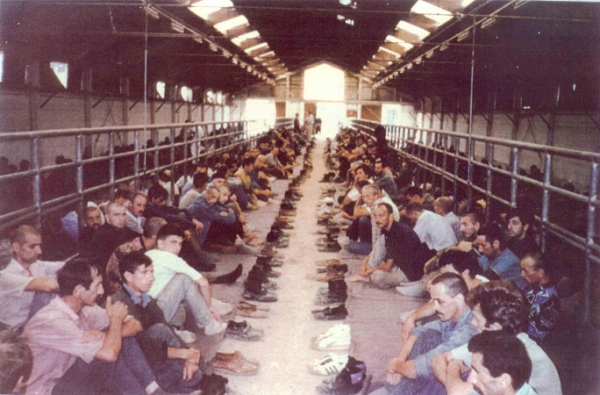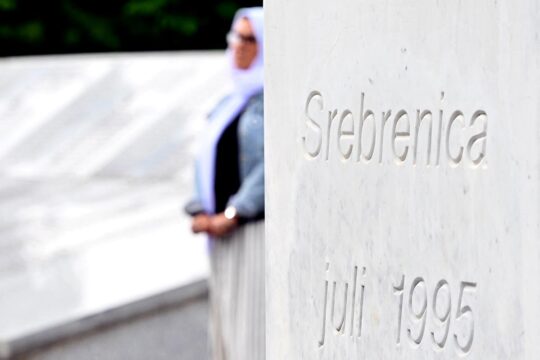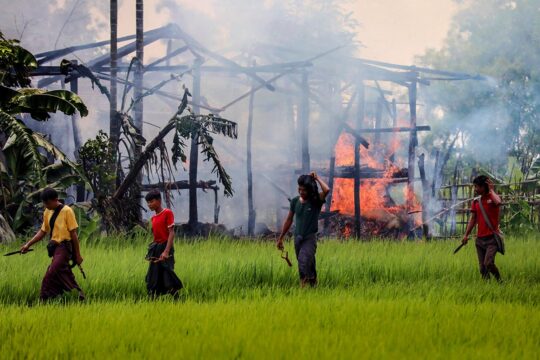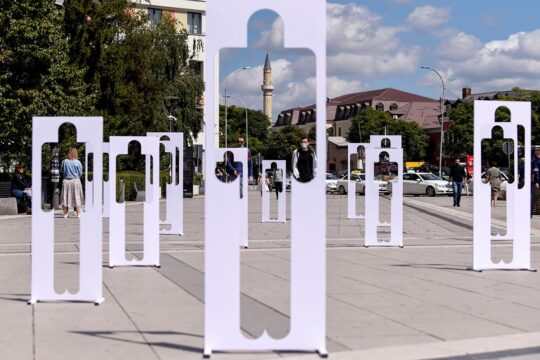The scene of one of the worst cases of war-related collective violence in Europe after the Second World War, Bosnia-Herzegovina (BiH) is still recovering from its recent violent past. In the face of the widespread atrocities committed during this conflict, as well as a disintegrated moral community and social fabric, transitional justice (TJ) initiatives, particularly trial-based measures, were brandished as the prevailing response. Yet, TJ measures, whether judicial (e.g. prosecutions by the International Criminal Tribunal for the Former Yugoslavia (ICTY) and national courts) or non-judicial (e.g. memorialization initiatives, fact-finding initiatives and mechanisms for documenting war crimes, attempts to establish a national and regional truth commission), which have been developed or envisaged in BiH, have often faced much criticism and attracted little support from the public. While some are considered to have achieved their goal locally, others have either failed to attain their purported objectives in terms of reconciliation or have even increased inter-ethnic divisions[i]. The dominant view in the country is that the existing TJ measures have not responded to the needs of their intended beneficiaries – the victims and survivors. They are often considered as externally imposed by various TJ actors, whether international or national, with insufficient concern for context-specific expectations of justice.[ii].
The implementation of judicial TJ measures: restoring the moral order while neglecting the social fabric?
Albeit aware that something had to be done to hold those responsible for the atrocities committed in BiH accountable, the international actors involved in finding a resolution to the conflict were initially hesitant to intervene and divided on the type of response. Many of them, especially those involved in the negotiation of the peace process, were reluctant to support the creation of an ad hoc international tribunal, as it could endanger the very strenuous peace negotiations.[iii]. The establishment of the ICTY in 1993, while the war was still raging, was from the onset justified by its supporters as an adequate reaction to achieve goals such as the restoration and maintenance of peace, an end to impunity and deterrence of future crimes. However, such objectives were later criticized for not having been achieved[iv], for having created unrealistic expectations[v] or for having been presumed without any empirical support for such claims[vi]. For example, the initiation of the first trials in The Hague in 1994 did not act as a deterrent, as evidenced by the Srebrenica genocide in 1995[vii]. The claim that prosecuting international crimes committed in BiH would lead to societal peace has also been widely questioned. One argument for such a stance is the lack of perceived legitimacy and acceptance of the ICTY at the local level especially among Bosnian Serbs and Croats[viii]. In addition, some of the ICTY’s latest decisions have been questioned even by international experts, further undermining its societal impact[ix] . Negative perceptions about the ICTY can reduce the validity and credibility of the facts about the past generated through these prosecutions. This can reinforce intergroup divisions by upholding polarized narratives of the past, which belittle the victimhood of former antagonists and deny in-group responsibility for past crimes[x]. Political elites have also been instrumentalizing negative views about the ICTY in order to remain in power and pursue their own political agendas[xi].
Despite these shortcomings, the ICTY produced some notable achievements, which leave an important long-term legacy that should be acknowledged. Its workings have produced an invaluable archive of documents and other evidence, which constitutes a unique historical record of events and facts. The Hague trials may never provide a complete picture of the roles of all protagonists involved in the crimes committed in BiH. Yet, they may help ensure that some undeniable facts, such as the Srebrenica genocide, will be integrated into Bosnian (and further regional) collective memory and will not be easily disputed by future generations[xii].
In the early 1990s, an international court was heralded as the best possible response “to do justice” in BiH. In fact, it was considered to be the only solution, given the lack of local resources, the devastated institutional structures, and the politicization of ethnicity plaguing the country. Nevertheless, in the face of the sheer mass of criminal cases to be processed, the necessity for complementary trial-based measures at the national level was quickly acknowledged. Conceived as a hybrid court involving international and national judges, which is to be gradually transformed into an institution involving only national judges, the special War Crimes Chamber of the Court of Bosnia and Herzegovina (WCC) was established in 2005. It was the first national court to have jurisdiction over international crimes in BiH. In line with the ICTY’s Completion Strategy, the majority of cases have thus been transferred to the WCC, as well as to sixteen other entity (regional) and cantonal courts across the country. While the ICTY is prosecuting its last cases, war crimes prosecutions are expected to continue within the national courts for an extended time (see for more details).
The above-mentioned retributive TJ measures have often been criticized for their lack of local ownership, and lack of participation in proceedings afforded to victims. This is related to outreach failings[xiii], a lack of engagement of local civil society actors (e.g. victims’ groups, NGOs)[xiv], as well as political and media propaganda aimed at undermining their credibility among the public[xv]. However, there is still hope for the delivery of effective justice in war crimes cases in BiH. The establishment of a National War Crimes Strategy in 2008 by the Council of Ministers can be considered a first step. Another indication is the launching in 2013 of a War Crimes processing project by the OSCE Mission in BiH with the aim of bolstering domestic prosecution capacities and expediting the backlog of war crimes cases fairly and efficiently. BiH’s European aspirations also promise a deeper involvement of the European Union in increasing Bosnian judicial capacities.
Non-judicial TJ measures: a future avenue for thick social reconstruction?
While judicial responses have prevailed in BiH, civil society initiatives aimed at non-judicial TJ measures have increasingly been developed in BiH[xvi]. These localized and often symbolic TJ measures are thought to foster reparation and acknowledgment through the recognition of victimization, the establishment of moral accountability and facts, as well as remembrance[xvii]. They represent social spaces in which an inclusive and reflexive social dialogue about the past can be instigated, thus countering the pervasive culture of denial surrounding crimes of the past in BiH.
Yet, within BiH, there are ongoing debates about whether the past should be addressed by the construction of a shared narrative. The value of acknowledging different, often conflicting, memories is increasingly recognized[xviii]. An example of such conflicting memories and narratives is the ongoing debate about the number of victims in Srebrenica, exemplified by the existence of at least two “truth commissions”, tasked with establishing the final number of victims[xix]. Although the Sarajevo-based commission (and the ICTY) came to a finding of around 8,000 people, the Banja-Luka sponsored commission insists on a much lower number of several hundred. Noteworthy examples of remembrance are the Bosnian Memories initiative, the Center for Civil Courage of the GARIWO NGO and a project to commemorate all victims, whether identified or still unidentified, developed by the International Commission on Missing Persons (ICMP) in collaboration with civil society actors (see for more information). Such measures are highly significant in raising awareness within the public sphere about the existence of multiple perspectives of the conflict. In a context where memorialisation has often been one-sided and exclusive[xx], such measures can foster an inclusive dialogue about the past between divided communities. Another promising project is RECOM, a regional truth-finding commission involving a coalition of civil society actors from several Balkans countries including BiH. Such a project, provided it overcomes its many political and financial constraints[xxi], could help integrate competing narratives of victimhood in order to establish a comprehensive account of the past.
In sum, while many localized initiatives have been developed against the backdrop of the conflicting interests of various justice stakeholders, the recent creation of a National Transitional Justice Strategy (still to be adopted by the BiH parliament) suggests that the development of more inclusive processes is also underway. There is a growing sense that such measures are essential to countering the negative effects of social and political divisions in BiH and to paving the way to a sustainable social reconstruction. However, such an outcome will depend on whether TJ measures meet local expectations and needs of justice, while reflecting a mutual acceptance and recognition of responsibility and suffering[xxii].
[i] Fischer & Petrovic-Ziemer, 2013; Kurze & Vukusic, 2013
[ii] Bougarel, 2007; Rangelov & Theros, 2009
[iii] Akhavan, 1996; Anonymous, 1996
[iv] Barria & Roper, 2005
[v] Clark, 2009a; Wu, 2013
[vi] Clark, 2011
[vii] Hazan, 2010
[viii] Kutnjak Ivkovic & Hagan, 2011; Ford, 2012
[ix] Gordy, E. (2012)
[x] Clark, 2009a
[xi] Subasic & Curak, 2014
[xii] Khan, 2014
[xiii] Clark, 2009b; Karwande, 2009
[xiv] Chehtman, 2011
[xv] Martin-Ortega, 2014
[xvi] Fischer & Petrovic-Ziemer, 2013
[xvii] Simić, 2013
[xviii] Guzina & Marijan, 2013
[xix] Nettelfield, L. & Wagner, S. (2014)
[xx] Morrow, 2012; Tepic, 2012
[xxi] Kurze & Vukusic, 2013
[xxii] Fischer & Petrovic-Ziemer, 2013; Weinstein, 2014






